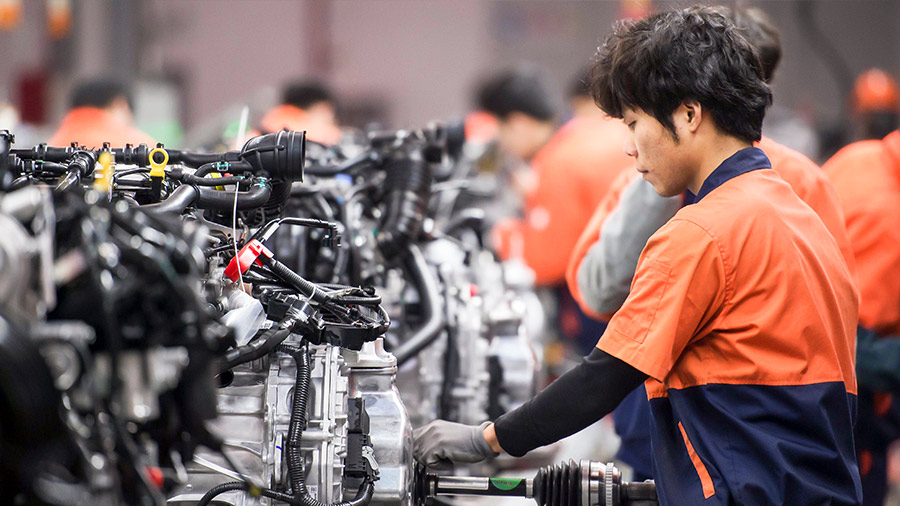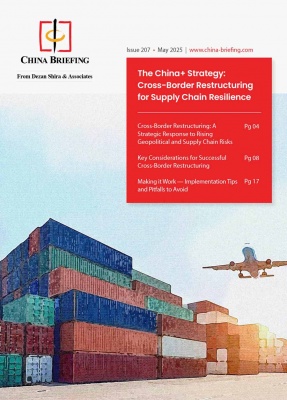Chris Devonshire-Ellis on China’s Continuing Development as a Global Trade Powerhouse
Op-Ed Commentary: Chris Devonshire-Ellis
Apr. 5 – Commentary, occasionally popular, that China has reached a plateau, is full of asset bubbles, and will begin to decline is off the mark. There are several important reasons for this.
Firstly, much of modern China’s growth has come from the manufacturing and export of products overseas, and this has led to a disproportionate amount of investment – and wealth generation – along its coastline. Prices and costs in these cities, such as Shanghai, have risen so much that they are getting close to developed country status. Yet still, in Shanghai while it is possible to buy a Porsche, it is also possible to purchase a bowl of noodles for US$1. Such financial diversity does not exist in Europe or the United States. This means that while certain market sectors in China cater for the very rich and are concentrated in wealthy seaboard cities, far larger (and more pragmatic and vital) markets continue to open up in China. China’s main focus the next decade is on improving the lot of the inland regions – and this means getting the Chinese heartland to consume. Much of China’s stimulus plans, including domestic ones introduced prior to the financial crisis such as the “Go West” initiative, have already paved the way.
While the reasons for going inland may be partially politically driven – a response to ethnic riots in Xinjiang and Tibet for example – there no doubt that the Chinese response in allocating billions of dollars for improving the local conditions in these, and many other inland areas, will significantly lift millions still more Chinese and ethnic non-Han Chinese out of poverty. If the last two decades were dominated by investment in China’s Han populated areas, the next will concentrate on its regions. That means a market of close to 700 million people in China will start to become accessible and, crucially, wealthy enough to develop as consumers. The China market may become more complex to Western investors as it does; the selling of goods and services in Chongqing and Urumqi is far different than is needed in Beijing or Shanghai. Yet such diversity is normal, and represents a massive opportunity. Investors should be aware that Chinese banknotes possesses seven languages, indication of the ethnic diversity and conditions within the country. Entrepreneurs familiar with these would be well advised to look at the related ethnic areas.
Secondly, China can also afford it. It is famously backed up by trillions of dollars of U.S. debt, and barring an unlikely collapse of the United States, has in fact invested wisely. Owning that debt will keep China from collapsing. It is linked to the United States regardless of the RMB-dollar rate of the moment, and that financial strength will enable China to continue to develop, to invest in education, infrastructure elsewhere and the lifting of its rural population into a consumer driven society.
Thirdly, to get there, China has already mapped out an engineering lead blueprint to achieve this. That is hardly surprising, given that interestingly, most of China’s top political leaders graduated as engineers. While in some cases China has invested in blind alleys (the Maglev for example), in others, such as high speed rail networks, it is transforming the way the nation is interconnected, and importantly, into other markets. Over the next two decades, China will expand its rail network and system into other countries and tie up with regional networks elsewhere (often funded by China in return for rare commodities) with the same gauge rail as well. Hence Chinese standard track will extend from China down into Singapore, across Russia, across Central Europe and will connect with Europe’s existing (and under construction) fast speed network. Hand in hand with its plans for highways, as well as the development of smaller Chinese and regional ports, China’s transportation network, infrastructure and developments will make China a world leader. Getting goods and services into and out of China will never have been easier.
Fourth, lies the “China plus” secret. China borders 14 countries, with many others, like Japan and South Korea, very close to hand. As China’s infrastructure starts to develop across its borders, its bilateral trade with all of its neighbors will increase by leaps and bounds. China is already investing in port facilities external from its borders in countries as diverse as Sri Lanka, Bangladesh, North Korea and Pakistan, and the opportunities that this creates will fuel further bilateral and regional growth in trade and commerce. The days of China’s leaders recalling Admiral Zeng He from his voyages overseas centuries ago are long over. China is now actively seeking foreign trade and partnership, and with fourteen neighbors on its doorstep, let alone opportunities in Africa, South America and beyond, China trade will continue to be the center of the global trade axis for some time to come.
 Chris Devonshire-Ellis is the founding partner of Dezan Shira & Associates. This article first appeared as a China investment essay in the recent 2point6billion.com report “China-India Investment, Trade and Tax Comparison” which may be downloaded in full on a complimentary basis from the Asia Briefing Bookstore.
Chris Devonshire-Ellis is the founding partner of Dezan Shira & Associates. This article first appeared as a China investment essay in the recent 2point6billion.com report “China-India Investment, Trade and Tax Comparison” which may be downloaded in full on a complimentary basis from the Asia Briefing Bookstore.
Chris also contributes to India Briefing , Vietnam Briefing , Asia Briefing and 2point6billion
Entrepreneurs and SME’s seeking investment advise about China should contact the firm at china@dezshira.com.
Related Reading: China Briefing’s Regional Investment Guides
Beijing and Northeast China
Shanghai and the Yangtze River Delta
South China and the Greater Pearl River Delta
Central China
West China
China’s Emerging Second and Third Tier Cities
- Previous Article China’s Non-manufacturing Sector PMI Rises to 58.4% in March
- Next Article Notice on Refund Policy of General Small Trade across Border Areas






























